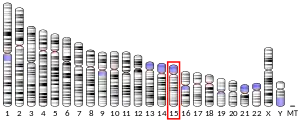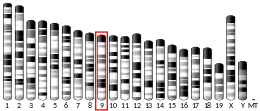DYX1C1
Dyslexia susceptibility 1 candidate gene 1 protein is a protein that in humans is encoded by the DYX1C1 gene.[5][6] This protein contains 420-amino acids with 3 tetratricopeptide repeat (TPR) domains, thought to mediate protein–protein interactions.
Clinical significance
A mutation in the DYX1C1 gene has been associated with deficits in reading ability (dyslexia).[5][7]
References
- GRCh38: Ensembl release 89: ENSG00000256061 - Ensembl, May 2017
- GRCm38: Ensembl release 89: ENSMUSG00000092192 - Ensembl, May 2017
- "Human PubMed Reference:". National Center for Biotechnology Information, U.S. National Library of Medicine.
- "Mouse PubMed Reference:". National Center for Biotechnology Information, U.S. National Library of Medicine.
- Taipale M, Kaminen N, Nopola-Hemmi J, Haltia T, Myllyluoma B, Lyytinen H, Muller K, Kaaranen M, Lindsberg PJ, Hannula-Jouppi K, Kere J (Oct 2003). "A candidate gene for developmental dyslexia encodes a nuclear tetratricopeptide repeat domain protein dynamically regulated in brain". Proc Natl Acad Sci U S A. 100 (20): 11553–8. doi:10.1073/pnas.1833911100. PMC 208796. PMID 12954984.
- "Entrez Gene: DYX1C1 dyslexia susceptibility 1 candidate 1".
- Bates TC, Lind PA, Luciano M, Montgomery GW, Martin NG, Wright MJ (November 2009). "Dyslexia and DYX1C1: deficits in reading and spelling associated with a missense mutation". Mol. Psychiatry. 15 (12): 1190–6. doi:10.1038/mp.2009.120. PMID 19901951.
Further reading
- Bates TC, Lind PA, Luciano M, Montgomery GW, Martin NG, Wright MJ (November 2009). "Dyslexia and DYX1C1: deficits in reading and spelling associated with a missense mutation". Mol. Psychiatry. 15 (12): 1190–6. doi:10.1038/mp.2009.120. PMID 19901951.
- Bonaldo MF, Lennon G, Soares MB (1997). "Normalization and subtraction: two approaches to facilitate gene discovery". Genome Res. 6 (9): 791–806. doi:10.1101/gr.6.9.791. PMID 8889548.
- Brkanac Z, Chapman NH, Matsushita MM, et al. (2007). "Evaluation of candidate genes for DYX1 and DYX2 in families with dyslexia". Am. J. Med. Genet. B Neuropsychiatr. Genet. 144 (4): 556–60. doi:10.1002/ajmg.b.30471. PMID 17450541.
- Cope NA, Hill G, van den Bree M, et al. (2005). "No support for association between dyslexia susceptibility 1 candidate 1 and developmental dyslexia". Mol. Psychiatry. 10 (3): 237–8. doi:10.1038/sj.mp.4001596. PMID 15477871.
- Gerhard DS, Wagner L, Feingold EA, et al. (2004). "The status, quality, and expansion of the NIH full-length cDNA project: the Mammalian Gene Collection (MGC)". Genome Res. 14 (10B): 2121–7. doi:10.1101/gr.2596504. PMC 528928. PMID 15489334.
- Marino C, Citterio A, Giorda R, et al. (2007). "Association of short-term memory with a variant within DYX1C1 in developmental dyslexia". Genes, Brain and Behavior. 6 (7): 640–6. doi:10.1111/j.1601-183X.2006.00291.x. PMID 17309662.
- Ota T, Suzuki Y, Nishikawa T, et al. (2004). "Complete sequencing and characterization of 21,243 full-length human cDNAs". Nat. Genet. 36 (1): 40–5. doi:10.1038/ng1285. PMID 14702039.
- Scerri TS, Fisher SE, Francks C, et al. (2005). "Putative functional alleles of DYX1C1 are not associated with dyslexia susceptibility in a large sample of sibling pairs from the UK". J. Med. Genet. 41 (11): 853–7. doi:10.1136/jmg.2004.018341. PMC 1735619. PMID 15520411.
- Strausberg RL, Feingold EA, Grouse LH, et al. (2003). "Generation and initial analysis of more than 15,000 full-length human and mouse cDNA sequences". Proc. Natl. Acad. Sci. U.S.A. 99 (26): 16899–903. doi:10.1073/pnas.242603899. PMC 139241. PMID 12477932.
- Wigg KG, Couto JM, Feng Y, et al. (2005). "Support for EKN1 as the susceptibility locus for dyslexia on 15q21". Mol. Psychiatry. 9 (12): 1111–21. doi:10.1038/sj.mp.4001543. PMID 15249932.
- Ylisaukko-Oja T, Peyrard-Janvid M, Lindgren CM, et al. (2005). "Family-based association study of DYX1C1 variants in autism". Eur. J. Hum. Genet. 13 (1): 127–30. doi:10.1038/sj.ejhg.5201272. PMID 15470369.
This article is issued from Wikipedia. The text is licensed under Creative Commons - Attribution - Sharealike. Additional terms may apply for the media files.



